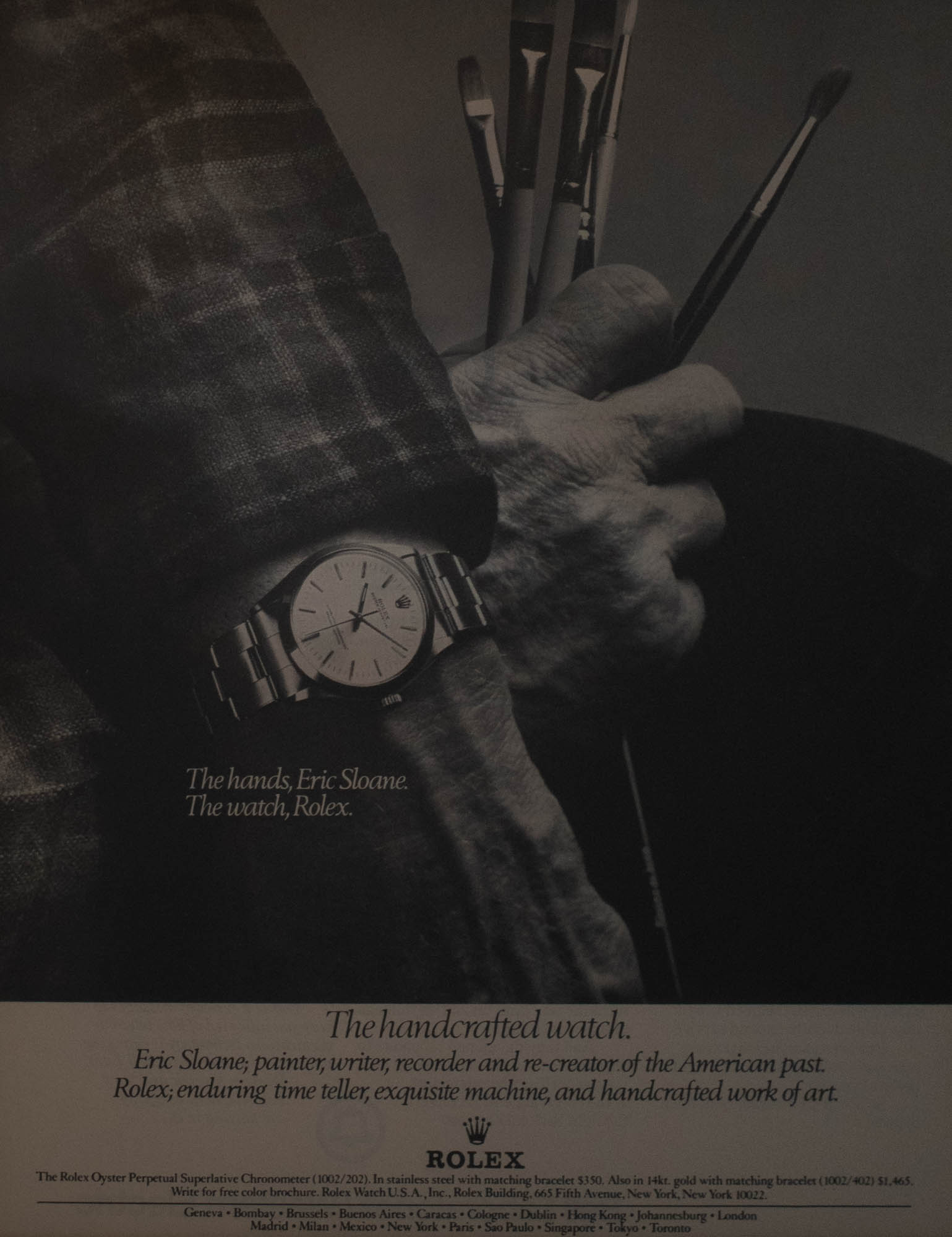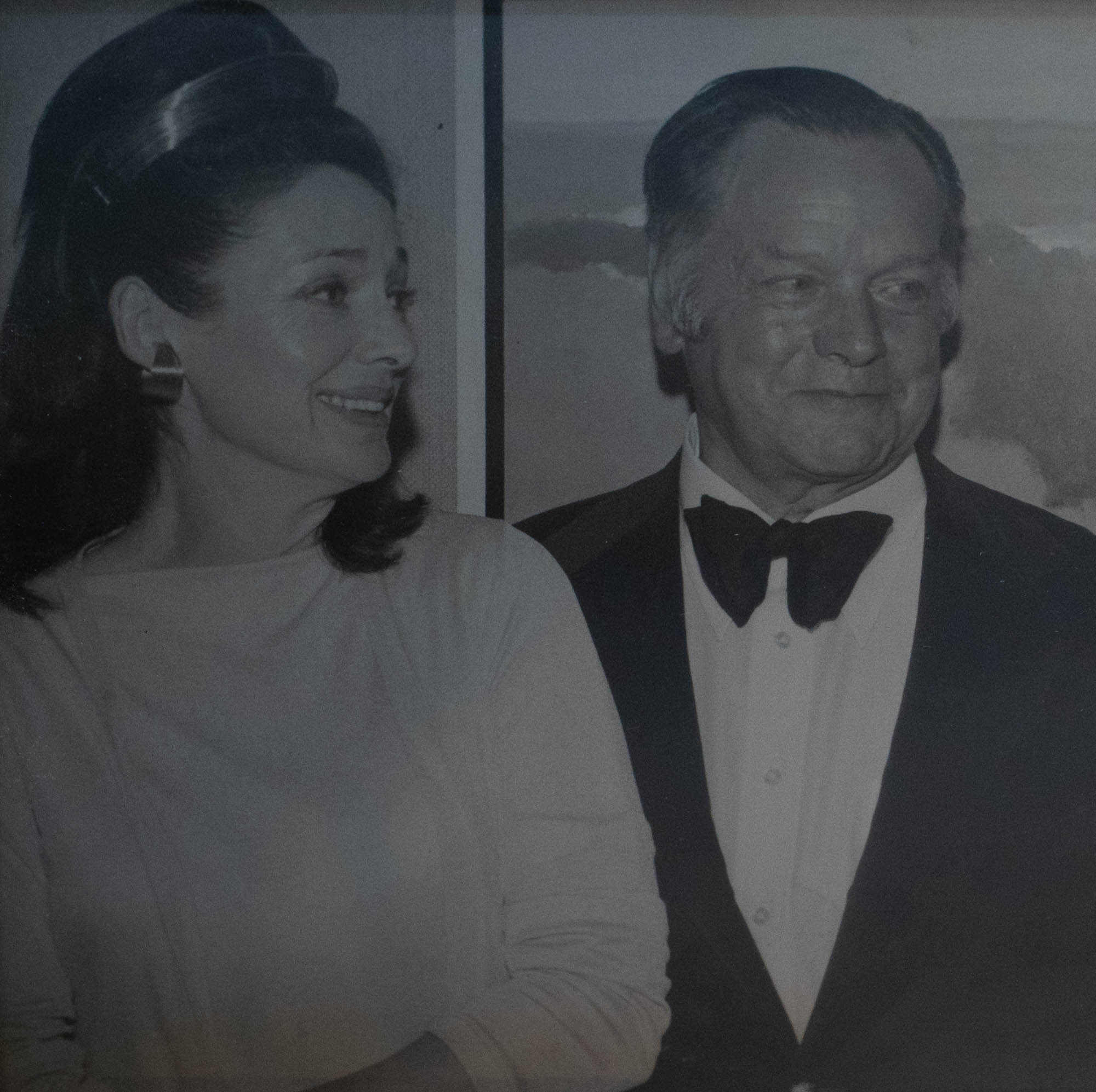

Remembered by his Widow, Mimi Sloane
Well-known American painter Eric Sloane died in 1985, but his widow, Mimi Sloane, remembers practically every detail about his life and work as if it happened yesterday. He divided his time between homes in Connecticut and Santa Fe and loved painting the east coast while he was in New Mexico and the southwestern landscape when he was in New England.
“He painted totally from memory,” Mrs. Sloane explains. “His work was all about shapes of light and dark, and he had a way of remembering exactly where the light came from when he worked in the studio. His eye was so quick that he only had to see a scene or object for a minute before it was imprinted in his memory forever.”
The Sloanes were married from 1965-85 and spent most of the later part of their marriage living in New Mexico. Sloane, who was born Everard Jean Hinrichs, first set foot in Taos in 1924. Young Everard pondered a suitable name to paint under and selected “Eric” from the center of the word “America”; then added Sloane, partly in honor of one of his mentors, John Sloan, from the Art Student League in New York City.
With his new name he moved back to Taos, began painting and lived at the guesthouse of famous Russian artist Leon Gaspard. He also spent time at Taos Pueblo. Depicting Indian ruins was one of his favorite endeavors.
Capturing nature in its infinite beauty was terribly important to Sloane. While he loved the southwestern landscape, he was equally drawn to New England’s quaint beauty. He liked rainy days and darkness. His heart was divided between capturing the sun-filled New Mexico skies, desert plains, and mountains and the moody, deciduous terrain of New England.
“He loved rendering clouds,”Mrs. Sloane recalls. “In fact, there are a whole group of cloud images I call the the ‘telephone paintings’ because he created them while talking on the phone.”
Sloane was a prolific painter who lived life as if he had only 20 minutes left. He could often complete a painting in a day. Visitors, except for his wife, were not allowed in the studio while he worked. Many completed canvases went to galleries while still wet. He wouldn’t allow her to hang any of his art in their homes. Part of the reason for this was that he didn’t want to look back at what he had done. He was always committed to looking forward. His motto, Mrs. Sloane says, was “tomorrow I have to do better than today.”
While Sloane lived intensely, he liked the slower pace of life nearly two centuries ago and felt the world of the 1800s represented the perfect balance of what life should be like. He meticulously painted old stone walls by putting a bit of gray next to a dab of darker paint, picking up a razor blade and scraping it through both across the surface of the canvas. A lead pencil was used to delineate the individual rocks carefully. When he painted shingles on an old barn or house, he ran the pointed side of a razor blade through the wet pigment.
“I used to watch him paint grass,” Mrs. Sloane recalls. “He would put three different colors of green next to each other to portray each individual blade of grass. He taught himself how to do this.”
Sloane was mostly self-taught, although he attended the Yale School of Fine Arts and the Arts Students League. He believed that schools were places to learn the fundamental principals of art. After mastering the basics, it was time to evolve an individual style away from an academic environment and the watchful eye of other artists. “Eric felt there was no such thing as talent,” Mimi Sloane states. “He felt that you just work at your art.”
In 1978 he became friends with gallery owner Michael Wigley and entrusted him with one of his finest exhibitions. In 1983 in Oklahoma City they presented a show titled “Portraits of America,” containing 30 paintings, all of which sold and many of which are in museums today.
Wigley’s Santa Fe gallery is the treasure house for the estate paintings today and he and Mimi have worked hand in hand with the estate, establishing foundation donations, museum support, and retrospective exhibits of the painter’s and the author’s art, writings, and artifact collections.
Sloane’s hard work paid off during his long career. His paintings are part of 54 permanent museum collections throughout the world more than any other American artist. In 1974 he was invited to show his work at the U.S.S.R. Academy of the Arts in Moscow by Leonid Brezhnev. To this day he remains the only American to receive this honor.
He established the Hall of Weather at the American Museum of Natural History. His breathtaking mural at the Smithsonian’s Air and Space Museum is one-half block long and six stories high.
In 1987 the National Cowboy Hall of Fame in Oklahoma City held a retrospective exhibition of Sloane’s work, with more than 50 paintings. One of his last and the only to be inscribed with his given initials, E.J.H., was acquired by the museum for its permanent collection.
When Sloane wasn’t painting, he enjoyed writing. He was a prolific author who created more than 50 books in 50 years.
“Eric was a very generous and trusting person,” Mrs. Sloane says. “He believed in painting what was inside him. His entire career was a journey of finding his own path.”
Eric Sloane's Painting Box
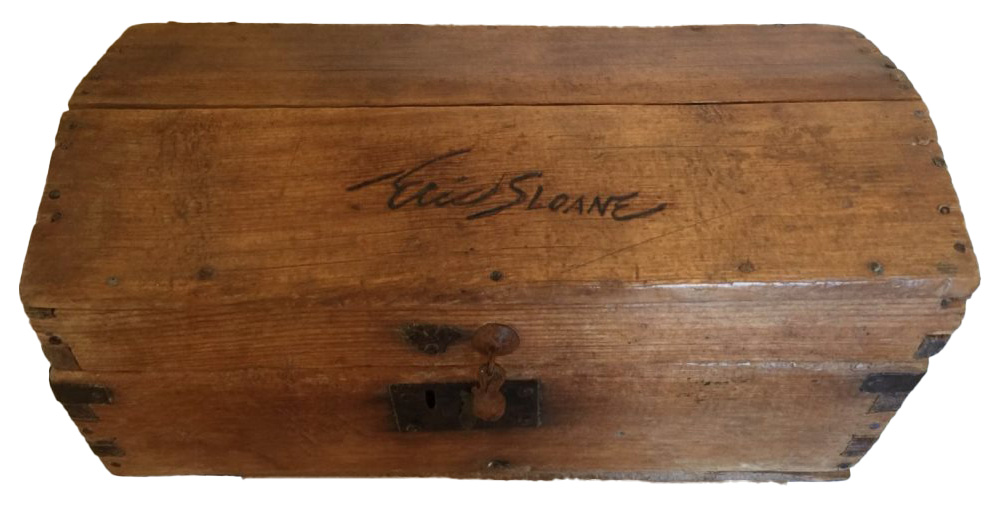
A chance encounter in the late 70's led a young Michael Wigley to refer a gentleman who was looking to sell several N.C. Wyeth paintings to Forrest Fenn's Santa Fe gallery. After a successful sale, a relationship was formed between the two galleries. Eventually, Forrest Fenn was able to convince Michael Wigley to move his gallery to Santa Fe from Oklahoma City. Forrest was the person who introduced Michael to Eric Sloane.
Eric Sloane's Painting Box holds a rich history that spans decades and continues to exist today, over thirty years since the artist's death. The box served as Eric Sloane's faithful companion throughout the latter half of his artistic journey, accompanying him on his travels between the Southwest and Northeast United States for many years.
Following Eric's passing in 1985, the box fell into the possession of Michael Wigley, the executor of Eric Sloane's Estate. Michael, who treasured the box for its rich heritage and historical significance, kept it in his gallery. During a visit to Michael's gallery, Forrest Fenn expressed a desire to purchase the Painting Box. However, Michael, understanding the sentimental importance of the box, respectfully declined the offer, firmly stating that it was not for sale.
Undeterred, Forrest persisted, attempting to pay for the box, but Michael firmly insisted that the box could not be bought. Instead, in a heartfelt gesture of friendship and admiration, Michael decided to present the painting box as a gift to Forrest. This act of generosity symbolized the enduring bond between the two friends and the profound significance of the painting box in their shared passion for art and heritage.
Forrest Fenn's Personal Tribute to Eric Sloane
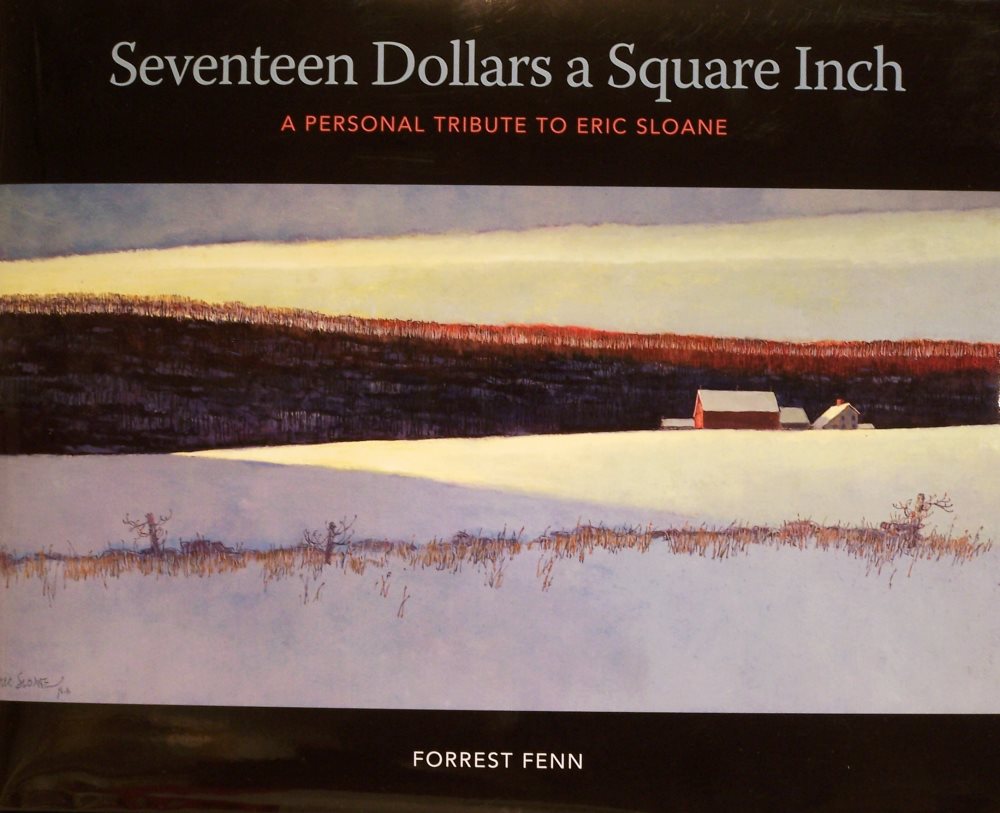
Smithsonian Institution Mural
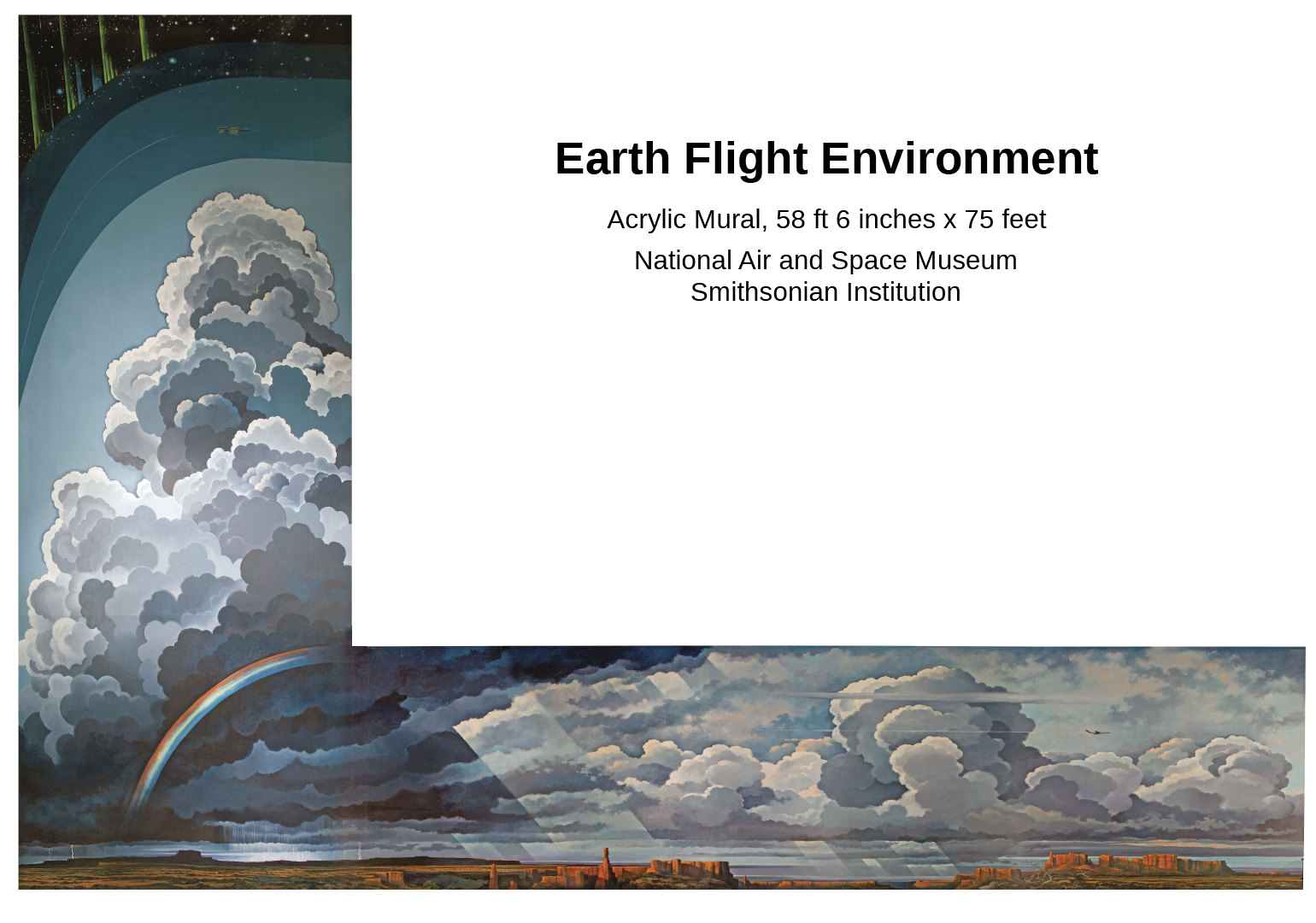
"Earth Flight Environment reached 58 feet 6 inches high and spans 75 feet in length."
"I painted the large mural for the air and Space Museum of the Smithsonian, having conceived and established the Hall of Weather for them a year earlier. Originally, I planned to turn down the mural; I remember my frightened state, as I am afraid of heights. But the astronaut Michael Collins talked me into taking the project. He said, 'How can you talk to a man who has been to the moon twice about being afraid of heights.' With that reasoning, I accepted the commission and found myself sucrrying up and down the zig-zag scaffold. Towering 50 feet high at the top of the painting made me feel quite nervous, as did having to use acrylic paint, which I constantly had to spray down to keep it from drying too quickly. Oil paint would not have lasted for such a mural and required too much continual maintenance. My painting, Earth Flight Environment, reached 58 feet 6 inches high and spans 75 feet in length. I completed the work in three weeks using over 100 gallons of acrylic paint. While I do not consider this to be my greatest painting, it is nonetheless a masterpiece of engineering for me as a painter."
Taken from Eric Sloane's America, Michael Wigley, 2009.
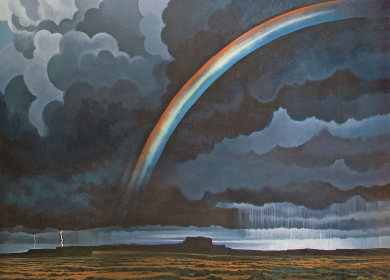
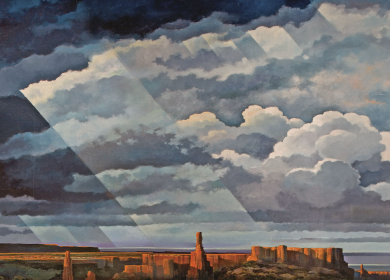
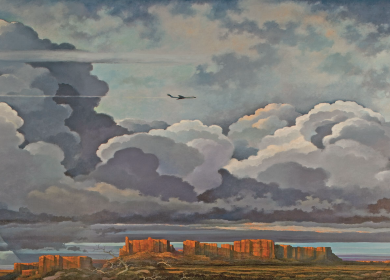
Eric Sloane's America - Michael Wigley
Eric Sloane Rolex Campaign
